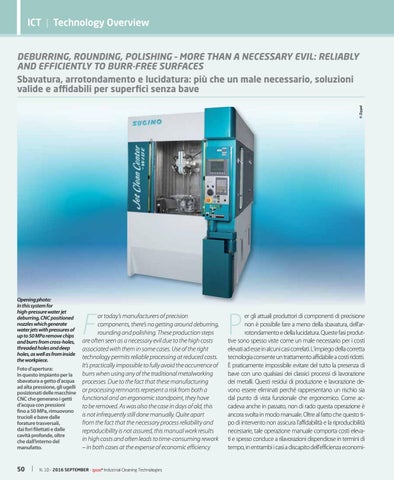ICT | Technology Overview
© Zippel
DEBURRING, ROUNDING, POLISHING – MORE THAN A NECESSARY EVIL: RELIABLY AND EFFICIENTLY TO BURR-FREE SURFACES Sbavatura, arrotondamento e lucidatura: più che un male necessario, soluzioni valide e affidabili per superfici senza bave
Opening photo: In this system for high-pressure water jet deburring, CNC positioned nozzles which generate water jets with pressures of up to 50 MPa remove chips and burrs from cross-holes, threaded holes and deep holes, as well as from inside the workpiece.
F
or today’s manufacturers of precision components, there’s no getting around deburring, rounding and polishing. These production steps are often seen as a necessary evil due to the high costs associated with them in some cases. Use of the right technology permits reliable processing at reduced costs. It’s practically impossible to fully avoid the occurrence of Foto d’apertura: burrs when using any of the traditional metalworking In questo impianto per la sbavatura a getto d’acqua processes. Due to the fact that these manufacturing ad alta pressione, gli ugelli or processing remnants represent a risk from both a posizionati delle macchine functional and an ergonomic standpoint, they have CNC che generano i getti d’acqua con pressioni to be removed. As was also the case in days of old, this fino a 50 MPa, rimuovono is not infrequently still done manually. Quite apart trucioli e bave dalle from the fact that the necessary process reliability and forature trasversali, dai fori filettati e dalle reproducibility is not assured, this manual work results cavità profonde, oltre in high costs and often leads to time-consuming rework che dall’interno del manufatto. – in both cases at the expense of economic efficiency 50
N. 10 - 2016 SEPTEMBER - ipcm® Industrial Cleaning Technologies
P
er gli attuali produttori di componenti di precisione non è possibile fare a meno della sbavatura, dell’arrotondamento e della lucidatura. Queste fasi produttive sono spesso viste come un male necessario per i costi elevati ad esse in alcuni casi correlati. L’impiego della corretta tecnologia consente un trattamento affidabile a costi ridotti. È praticamente impossibile evitare del tutto la presenza di bave con uno qualsiasi dei classici processi di lavorazione dei metalli. Questi residui di produzione e lavorazione devono essere eliminati perché rappresentano un rischio sia dal punto di vista funzionale che ergonomico. Come accadeva anche in passato, non di rado questa operazione è ancora svolta in modo manuale. Oltre al fatto che questo tipo di intervento non assicura l’affidabilità e la riproducibilità necessarie, tale operazione manuale comporta costi elevati e spesso conduce a rilavorazioni dispendiose in termini di tempo, in entrambi i casi a discapito dell’efficienza economi-
